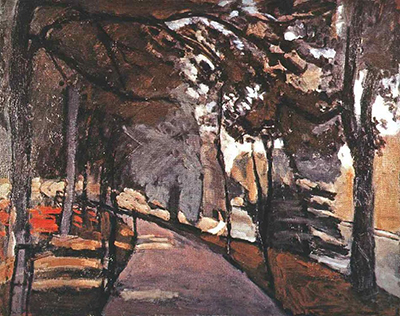The Path in the Bois de Boulogne by Henri Matisse was painted in 1903 as oil on canvas and is one of the artist's most well-known ruminations on a landscape in the Post-Impressionist style.
Its size and scope are very much influenced by Cezanne, who Matisse once described as 'the father of us all' when it came to Expressionist artwork. The Path in the Bois de Boulogne by Henri Matisse is a dense, almost suffocating piece, with heavy leafed trees bending their boughs over an open path, the end of which cannot be seen. The colours are different shades of purple, brown and grey, which also adds to the oppressive and dense feeling of the painting. Matisse's landscapes tend to be of more cultivated public spaces, such as parks or private gardens, with The Path in the Bois de Boulogne by Henri Matisse marking a departure from this usual subject matter and is certainly much more rustic in its conception too.
The Path in the Bois de Boulogne by Henri Matisse also follows on from Matisse's celebrated collection of landscapes painted during his time in Toulouse and Corsica, however their colours are much more vibrant and alive than those chosen for The Path in the Bois de Boulogne. The painting is not completely eerie however, thanks to the dappling sunlight that sneaks through the trees and washes their light across the purple coloured path. Unlike Cezanne however, the trees do not seem to have any kind of internal structure and instead of clear and defined branches, are shown to be a mass of indistinguishable leaves instead.
The Path in the Bois de Boulogne by Henri Matisse was painted during the artist's Fauvism period, where the attention was on using colour in unusual and unexpected ways in order to elicit an emotional response from the viewer. Although Fauvism had begun to wane in popularity by the time The Path in the Bois de Boulogne by Henri Matisse was painted, its innovative use of colour was still recognised and commented on by his contemporaries. Indeed, poet and playwright of the time, Guillaume Apollinaire, noted that whilst Matisse continued to push at the boundaries of modern art, his works were still somehow palatable and not too revolutionary, describing Matisse's art as 'eminently reasonable'. However, critics of the time were not so impressed, and this period of Matisse's artistic career was met with some harsh criticism, which saw his art subsequently change direction.




